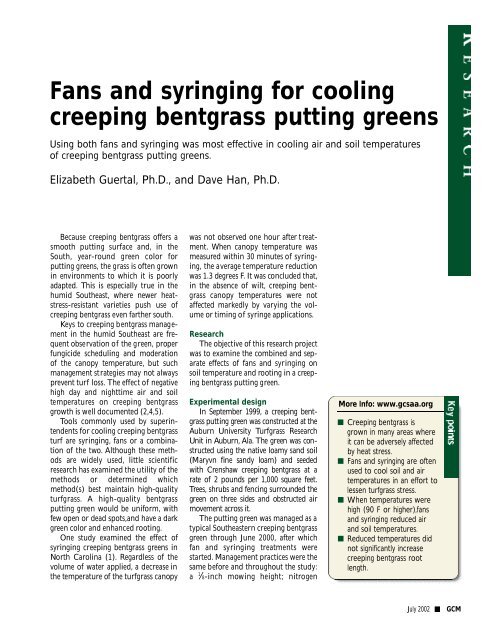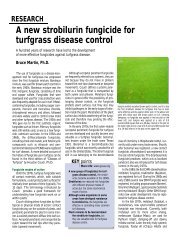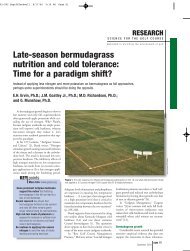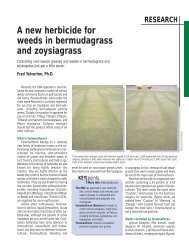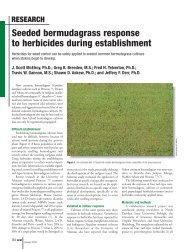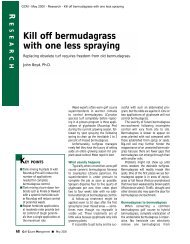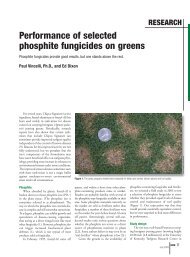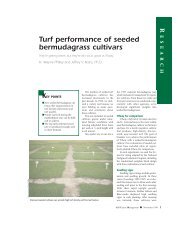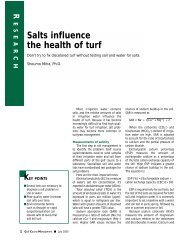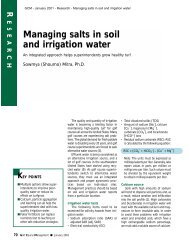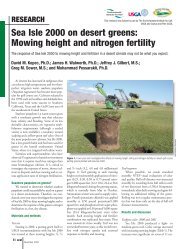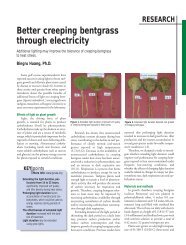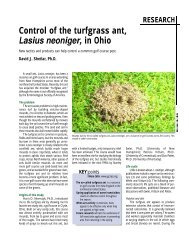Fans and syringing for cooling creeping bentgrass putting ... - GCSAA
Fans and syringing for cooling creeping bentgrass putting ... - GCSAA
Fans and syringing for cooling creeping bentgrass putting ... - GCSAA
Create successful ePaper yourself
Turn your PDF publications into a flip-book with our unique Google optimized e-Paper software.
<strong>Fans</strong> <strong>and</strong> <strong>syringing</strong> <strong>for</strong> <strong>cooling</strong><strong>creeping</strong> <strong>bentgrass</strong> <strong>putting</strong> greensUsing both fans <strong>and</strong> <strong>syringing</strong> was most effective in <strong>cooling</strong> air <strong>and</strong> soil temperaturesof <strong>creeping</strong> <strong>bentgrass</strong> <strong>putting</strong> greens.Elizabeth Guertal, Ph.D., <strong>and</strong> Dave Han, Ph.D.Because <strong>creeping</strong> <strong>bentgrass</strong> offers as m ooth put ting su rf ace <strong>and</strong>, in theSo ut h , ye a r- round green co l or <strong>for</strong><strong>putting</strong> greens, the grass is often grownin environments to which it is poorlyadapted. This is especially true in thehumid Southeast, where newer heatstre s s - resistant va ri eties push use of<strong>creeping</strong> <strong>bentgrass</strong> even farther south.Keys to <strong>creeping</strong> <strong>bentgrass</strong> managementin the humid Southeast are frequentobservation of the green, properfungicide scheduling <strong>and</strong> moderationof the canopy temperature, but suchmanagement strategies may not alwaysprevent turf loss. The effect of negativehigh day <strong>and</strong> nighttime air <strong>and</strong> soiltem pera tu res on <strong>creeping</strong> ben t gra s sgrowth is well documented (2,4,5).Tools commonly used by superintendents<strong>for</strong> <strong>cooling</strong> <strong>creeping</strong> <strong>bentgrass</strong>turf are <strong>syringing</strong>, fans or a combinationof the two. Although these methodsare wi dely used , little scien ti f i cresearch has examined the utility of them et h ods or determ i n ed wh i chmethod(s) best maintain high-qualitytu rfgra s s . A high - qu a l i ty ben t gra s s<strong>putting</strong> green would be uni<strong>for</strong>m, withfew open or dead spots,<strong>and</strong> have a darkgreen color <strong>and</strong> enhanced rooting.One study examined the effect of<strong>syringing</strong> <strong>creeping</strong> <strong>bentgrass</strong> greens inNorth Carolina (1). Regardless of thevolume of water applied, a decrease inthe temperature of the turfgrass canopywas not observed one hour after t reatment.When canopy temperature wasmeasured within 30 minutes of <strong>syringing</strong>,the average temperature reductionwas 1.3 degrees F. It was concluded that,in the absence of wilt, <strong>creeping</strong> <strong>bentgrass</strong>canopy tem pera tu res were notaffected markedly by varying the volumeor timing of syringe applications.ResearchThe objective of this research projectwas to examine the combined <strong>and</strong> separateeffects of fans <strong>and</strong> <strong>syringing</strong> onsoil temperature <strong>and</strong> rooting in a <strong>creeping</strong><strong>bentgrass</strong> <strong>putting</strong> green.Experimental designIn Septem ber 1999, a <strong>creeping</strong> ben t-grass put ting green was con s tru cted at theAu bu rn Un ivers i ty Tu rfgrass Re s e a rchUnit in Au bu rn ,Al a . The green was constru cted using the native loa my s<strong>and</strong> soi l( Ma ryvn fine s<strong>and</strong>y loam) <strong>and</strong> seededwith Cren s h aw <strong>creeping</strong> ben t grass at ara te of 2 pounds per 1,000 squ a re feet .Tree s , s h rubs <strong>and</strong> fencing su rro u n ded thegreen on three sides <strong>and</strong> ob s tru cted airm ovem ent ac ross it.The <strong>putting</strong> green was managed as atypical Southeastern <strong>creeping</strong> <strong>bentgrass</strong>green through June 2000, after whichfan <strong>and</strong> syri n ging tre a tm ents werestarted. Management practices were thesame be<strong>for</strong>e <strong>and</strong> throughout the study:a 1 ⁄8- i n ch mowing hei gh t ; n i trogenMore Info: www.gcsaa.org■ Creeping <strong>bentgrass</strong> isgrown in many areas whereit can be adversely affectedby heat stress.■ <strong>Fans</strong> <strong>and</strong> <strong>syringing</strong> are oftenused to cool soil <strong>and</strong> airtemperatures in an ef<strong>for</strong>t tolessen turfgrass stress.■ When temperatures werehigh (90 F or higher),fans<strong>and</strong> <strong>syringing</strong> reduced air<strong>and</strong> soil temperatures.■ Reduced temperatures didnot significantly increase<strong>creeping</strong> <strong>bentgrass</strong> rootlength.July 2002GCM
A 20-inch nonoscillating fan was set up at theedge of each experimental plot to test the<strong>cooling</strong> effect of fans on <strong>creeping</strong> bentgr a s s .applied at 0.1 pound/1,000 square feetper week; phosphorus, potassium <strong>and</strong>lime applied to soil-test recommendations;monthly topdressing to apply alight dusting, which was brushed in;<strong>and</strong> vertical mowing in non s tre s smonths (October, January) to aid inthatch removal.The stu dy was arra n ged in a split-plotde s i gn . The fan tre a tm ents were themain bl ock s , <strong>and</strong> the syri n ge tre a tm en t swere split bl ock s . Main bl ocks of f a ntre a tm ents were 10 feet by 20 feet , wi t hthe syri n ge split bl ocks measu ring 10 feetby 10 feet . A 10-foot all ey su rro u n dede ach plot. Th ere were three rep l i c a ti on sof e ach fan or syri n ge tre a tm en t .To app ly the fan tre a tm en t ,one 20-i n ch non o s c i ll a ting fan (Tem pe s tTech n o l ogy Corp.) was mounted at ah ei ght of 3 feet at the end of e ach fanbl ock . To minimize the ef fect of a high erfan speed in areas close to the fans, e achfan was placed 10 feet aw ay from theed ge of the plot. In ad d i ti on ,in the secondyear of the stu dy, fans were movedf rom one end of e ach main bl ock to theo t h er en d . Every day the fans ran from11:15 a.m. to 4:15 p. m .Low - vo lume misting irri ga ti onheads (Rain Bird Corp.) placed at eachcorner of the plots applied the syringetreatments. Syringe applications weremade three times each day (noon, 2p.m. <strong>and</strong> 4 p.m.) <strong>for</strong> two minutes persyringe cycle. The average (from weeklys a m p l i n gs ) tem pera tu re of the mistwater was 70 F.In each year of the study (2000 <strong>and</strong>2001), treatments began when daytimea f tern oon tem pera tu res con s i s ten t lyreached 85-90 F, about the first week ofJune. The study ended <strong>for</strong> the yearwhen air temperatures dropped out ofthis range, usually in the first week ofSeptember.Collected data included soil temperatureat a depth of 1 ⁄2 inch, using continuouslymeasuring (every 5 minutes)temperature probes placed in each plot(Hobo Corp.). Each week from Junethrough September, root samples (0-6inches) were removed <strong>for</strong> root-lengthanalysis. Collected roots were dyed withCongo red, <strong>and</strong> the total length of allthe roots was analyzed via a light table.Results <strong>and</strong> discussionSoil temperature<strong>Fans</strong> <strong>and</strong> <strong>syringing</strong> often produceds t a ti s ti c a lly s i gnificant differen ces insoil temperature. Statistical analysis ofthe data revealed that both fans <strong>and</strong><strong>syringing</strong> often lowered soil temperature,<strong>and</strong> that the combination of fans<strong>and</strong> <strong>syringing</strong> sometimes lowered soiltem pera tu re more than the fan orsyringe treatments alone.A graph illustrates Aug. 15, 2000, atypical day of data collection. The topbox in the figure shows 24 hours of dataco ll ecti on ; the bo t tom box is anenlargement from that data set, showingthe tem pera tu re data ga t h eredwhile the fans were running. As shownin the upper portion of the graph, soiltemperatures dropped throughout theevening, night <strong>and</strong> early morning <strong>and</strong>began to rise around 7 a.m. As soon asthe fan <strong>and</strong> syringe treatments began atabout 11 a.m., their effect on soil temperaturewas evident. Soil temperaturesdecreased in the fan-only, syringe-only<strong>and</strong> fan + syringe treatments as comparedto the untreated control plots.To determine wh en the va rious tre a t-m ents affected the soil tem pera tu re , wea n a ly zed the data at five - m i nute interval s . Si gnificant fan-by - s yri n ge interactions occ u rred most of ten in the houra f ter a syri n ge app l i c a ti on . Because ofeva pora tive coo l i n g, the soil tem peratures in plots receiving fan + syri n getre a tm ents were lower than those ofo t h er tre a tm en t s . The fan-by - s yri n gei n teracti on typ i c a lly rem a i n ed stati s tica lly significant until abo ut 6 p. m .,a f terwh i ch the main ef fect of fan coo l i n gs om etimes rem a i n ed stati s ti c a lly s i gn i f-i c a n t . The ef fect of the fan tre a tm ent ons oil tem pera tu re usu a lly rem a i n ed unti la bo ut 2 a.m.After 2 a.m., none of the treatmentshad a statistically significant effect untilthe fans were re s t a rted later in themorning. Once the fans were runningGCM July 2002
again, the main effect of the fan treatmentbecame significant between 11:30a.m. <strong>and</strong> noon. The significance of thismain effect remained until the significantfan-by - s yri n ge interacti onoccurred again, around the time of thefirst syringe application at noon.The ef fects of fans <strong>and</strong> syri n gi n g( both toget h er <strong>and</strong> sep a ra tely) werem ore pron o u n ced wh en air tem peratures were high er. Su m m er 2000 wash o t ter than su m m er 2001. For ex a m-p l e , in Ju ly <strong>and</strong> August 2000, avera gem a x i mum air tem pera tu res were 95<strong>and</strong> 93 F, re s pectively. In August 2001,the avera ge maximum air tem pera tu rewas 88 F. By Ju ly 20, 2000 , air tem peratu res on 15 days had exceeded 90 F,<strong>and</strong> one of those days had exceeded100 F. By Au g. 15 , 2000 , a total of 35d ays with air tem pera tu res gre a terthan 90 F had occ u rred . In com p a rison , du ring that same peri od in 2001,on ly 23 days had had air tem pera tu re sexceeding 90 F, <strong>and</strong> the tem pera tu ren ever re ach ed 100 F. Even with morem odera te tem pera tu res in the 2001sampling ye a r, d i f feren ces in soil temperatu re as a re sult of fans <strong>and</strong> syri n g-ing were of ten sign i f i c a n t , but not asf requ en t ly as in 2000, the hotter ye a r.Di f feren ces in rel a tive hu m i d i tybet ween 2000 <strong>and</strong> 2001 were notnoticeable, <strong>and</strong> humidity was typicallyhigh. In June, July <strong>and</strong> August 2000,theaverage maximum relative humidities<strong>for</strong> each month were 91, 88 <strong>and</strong> 92 percent , re s pectively. In Ju n e , Ju ly <strong>and</strong>August 2001, the average maximum relativehumidities were 92,94 <strong>and</strong> 95 percent . In a typical mon t h , rel a tivehumidity exceeded 90 percent during atleast two weeks <strong>and</strong> ra rely droppedbelow 80 percent. This was especiallytrue in August.Wh en ra i n , exce s s ive wind or coo l ertem pera tu res preva i l ed , n ei t h er fansn or syri n ging redu ced tem pera tu re s .For ex a m p l e , in 2001 wh en Trop i c a lS torm Ba rry moved inl<strong>and</strong>, t h ere werefew stati s ti c a lly s i gnificant re s ponses tofans or syri n gi n g. Soil tem pera tu rere s ponse to fans <strong>and</strong> syri n gi n ga ppe a red to be s t a ti s ti c a lly sign i f i c a n twh en air tem pera tu res were con s i s-ten t ly high er than 90 F, n i ghts were hot(>75 F) <strong>and</strong> hu m i d i ty was high .Root len g t hRoot length increase under fan treatmentswas never significant (α = 0.05).Syri n ging never affected roo t - l en g t hdensity. In 2000, average root-lengthdensity decreased in July <strong>and</strong> increasedin August. In 2001, root-length densitydec re a s ed thro u gh o ut the samplingperiod.<strong>Fans</strong> <strong>and</strong> <strong>syringing</strong> vs. soil temperature95908580757096949290888684820<strong>Fans</strong>runningTime of day■ Fan <strong>and</strong> syringe treatments■ Fan treatments only■ Syringe treatments only■ No fan or syringe treatmentsThe effects of the various experimental treatments are shown <strong>for</strong> Aug. 15, 2000. Thecombination of fans <strong>and</strong> <strong>syringing</strong> caused the greatest decrease in soil temperatures.July 2002GCM
<strong>Fans</strong> <strong>and</strong> <strong>syringing</strong> vs. roots353025201510503530252015105035302520151050200020002001■ Fan■ No fan■ Syringe■ No Syringe■ Fan■ No fanTurf quality <strong>and</strong> colorTu rf qu a l i ty <strong>and</strong> co l or were sign i f i c a n t ly affected by fan, s yri n geor the com bi n a ti on of fan <strong>and</strong> syri n ge tre a tm ents on five of s evenra ting date s . Using a 1-9 scale,plots were rated <strong>for</strong> color <strong>and</strong> quality,with a color score of 1 assigned to a completely brown plot,<strong>and</strong>a quality score of 1 assigned to a plot with no living turf.Plots withacceptable color or quality received scores of 5. At three ratings(June <strong>and</strong> August 2000 <strong>and</strong> July 2001), the interaction of fans <strong>and</strong><strong>syringing</strong> was significant, because the combination of fans <strong>and</strong><strong>syringing</strong> improved turf color beyond that observed in the fanonly,syringe-only or untreated plots.When the fan-only treatment was significant (July <strong>and</strong> August2001), turf quality was improved when a fan was used. For example,the average turf quality rating on July 17, 2001, was 6.0 <strong>for</strong>plots with fans <strong>and</strong> 5.2 <strong>for</strong> those without. On Aug. 1, 2001, turfquality in plots with fans averaged 6.0, turf quality in plots withoutfans averaged 4.7. Fan or <strong>syringing</strong> treatments negatively affectedturf color or quality only once, on Aug. 25,2000, when plots receivingonly the syringe treatment had a lower color score than thosenot receiving syringe sprays.Conclusions• Both the fan <strong>and</strong> syri n ge tre a tm ents coo l ed the soil tem pera tu re( m e a su red at a depth of 1 ⁄2 i n ch) of c reeping ben t grass put ti n ggreens du ring the two ye a rs of this stu dy.• The combined treatment of fans + <strong>syringing</strong> was most effective.The fan treatment alone lowered soil temperature, but not asmuch as fans <strong>and</strong> <strong>syringing</strong> combined.• The <strong>cooling</strong> effect of the fan treatment often lasted after the fanshad stopped running. This residual effect typically lasted aboutfour hours.• When air temperatures were lower than 90 F, the treatmenteffects were less pronounced.• Reduced soil temperature did not produce a significant increasein <strong>creeping</strong> <strong>bentgrass</strong> root length.■AcknowledgmentsThanks to the Tem pest Tech n o l ogy Corp. <strong>for</strong> loaning the fans <strong>and</strong> to theAlabama Tu rfgrass Re s e a rch Fo u n d a ti on <strong>for</strong> su pporting this re s e a rch .353025201510502001■ Syringe■ No SyringeReferences1. DiPaola, J. 1984. Syringing effects on the canopy temperatures of <strong>bentgrass</strong>greens. Agronomy Journal 76:951-953.2. Huang, B.,<strong>and</strong> H. Gao. 2000. Growth <strong>and</strong> car bohydrate metabolism o f <strong>creeping</strong><strong>bentgrass</strong> cultivars in response to increasing temperatures. Crop Science40:1115-1120.3. Va r ga s , J. M . ,J r. 1 9 9 4 . Ma n a gem ent of tu rfgrass diseases. Lewis Pu bl i s h ers , Boc aRa ton ,F l a .4. Xu,Q., <strong>and</strong> B. Huang. 2000a. Growth <strong>and</strong> physiological responses of <strong>creeping</strong><strong>bentgrass</strong> to changes in air <strong>and</strong> soil temperatures. Crop Science 40:1363-1368.5. Xu,Q.,<strong>and</strong> B. Huang. 2000b. Effects of differential air <strong>and</strong> soil temperature oncarbohydrate metabolism in <strong>creeping</strong> <strong>bentgrass</strong>. Crop Science 40:1368-1374.Neither fans nor <strong>syringing</strong> significantly affected root-length density in 2000 or 2001.In 2001, root-length density actually decreased throughout the sampling period.Elizabeth Guertal, Ph.D. (e-mail: eguertal@acesag.auburn.edu), is Alumni AssociateProfessor, <strong>and</strong> Dave Han, Ph.D., is an assistant professor <strong>and</strong> Extension specialist,inthe department of agronomy <strong>and</strong> soils at Auburn University, Auburn, Ala.GCM July 2002


